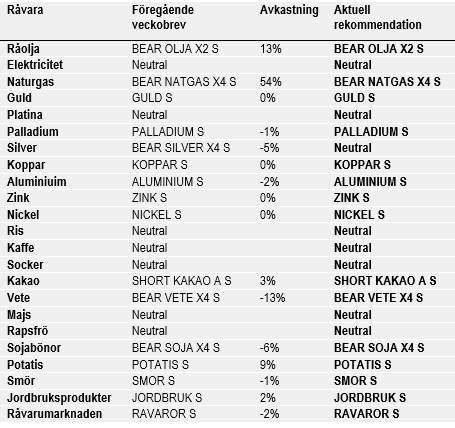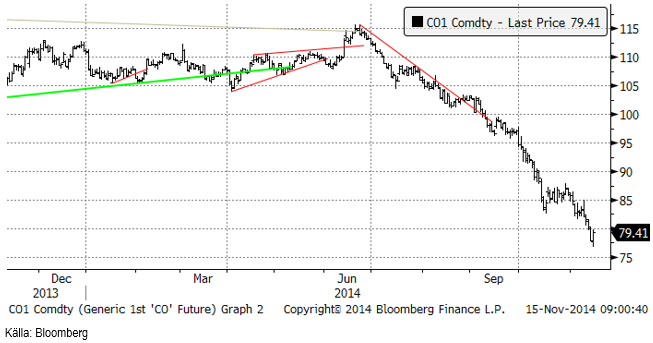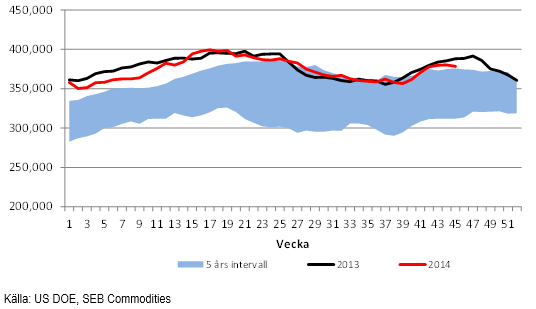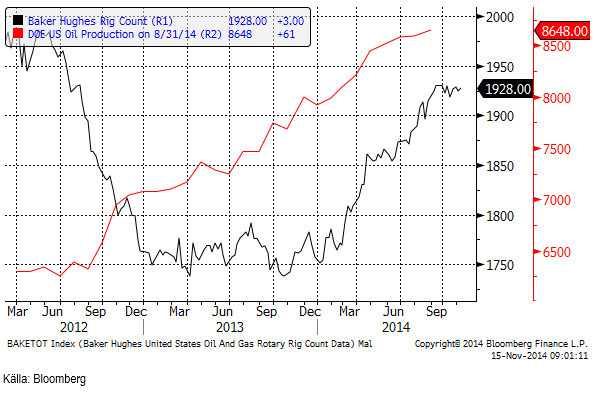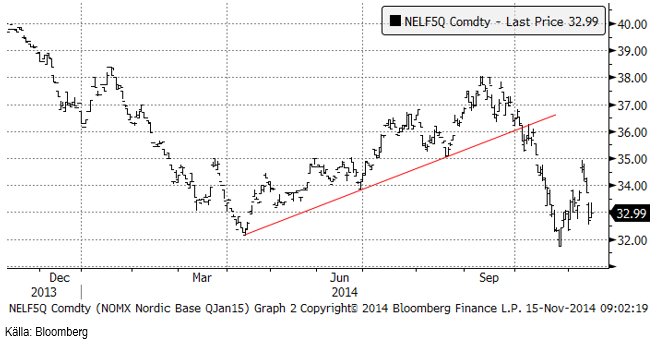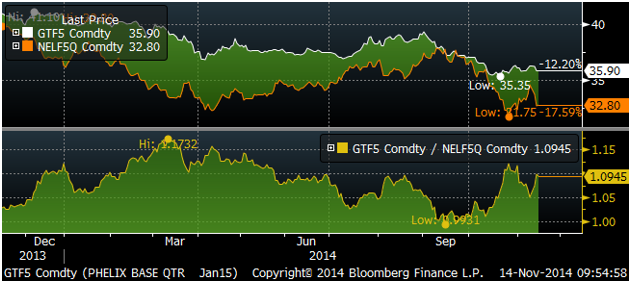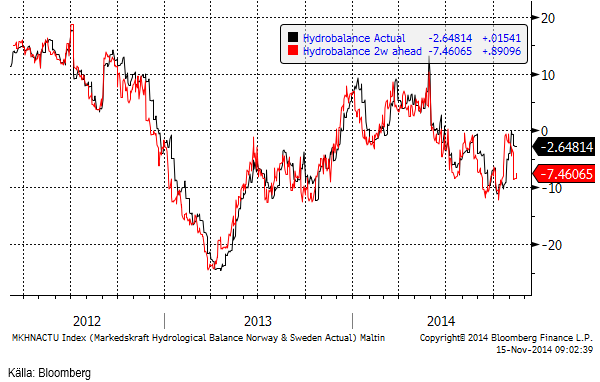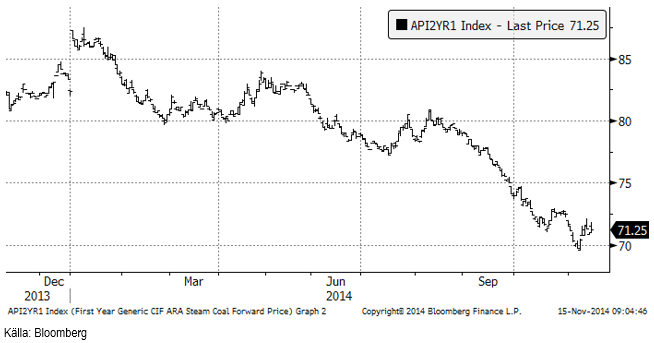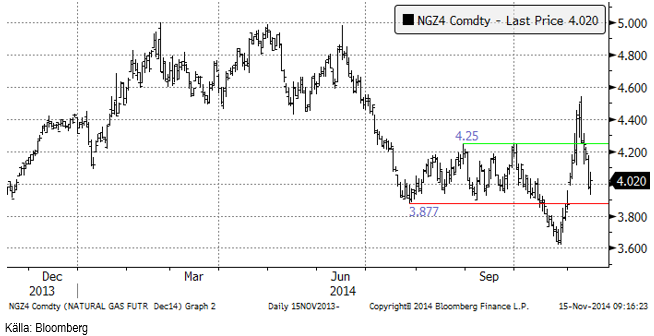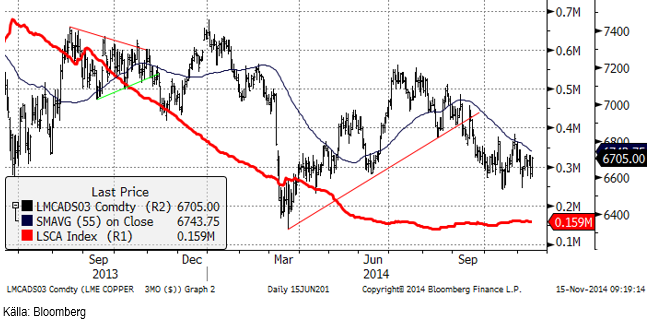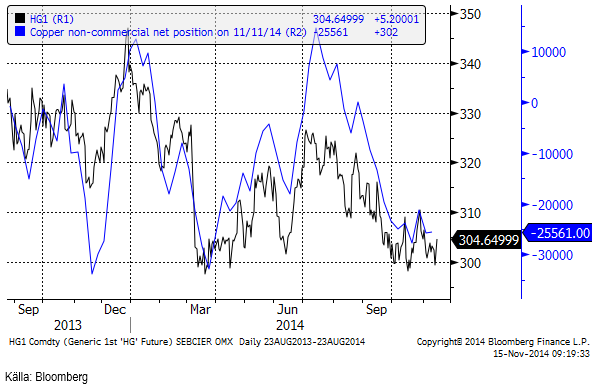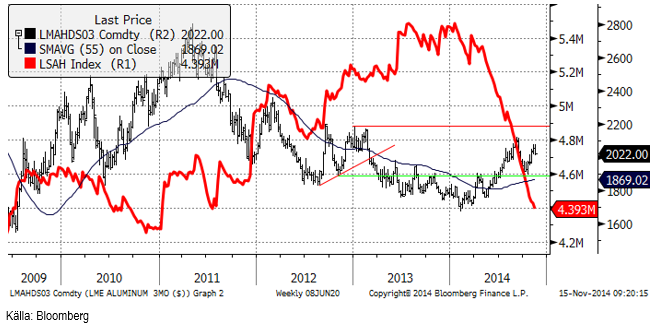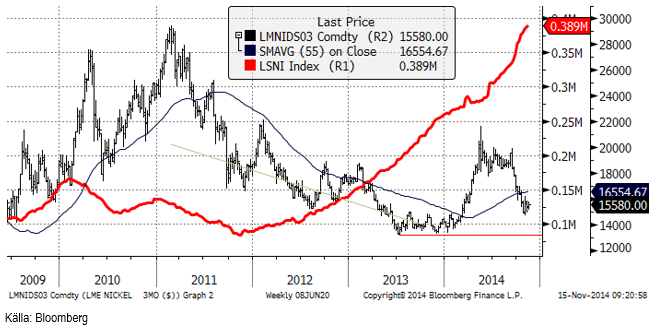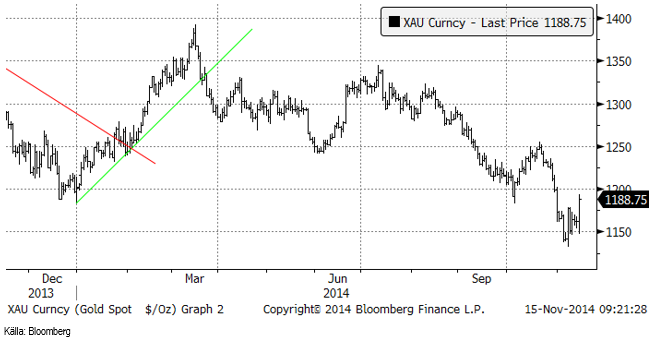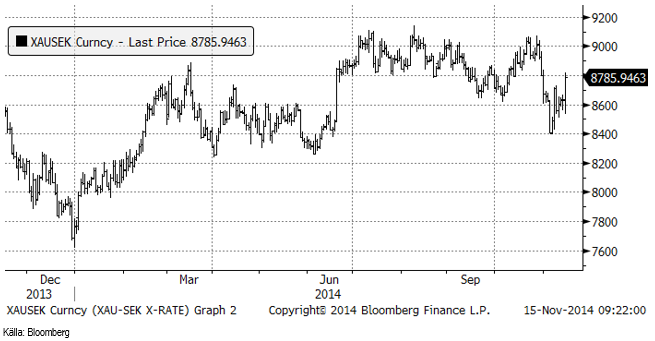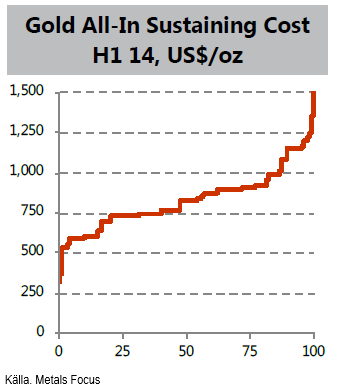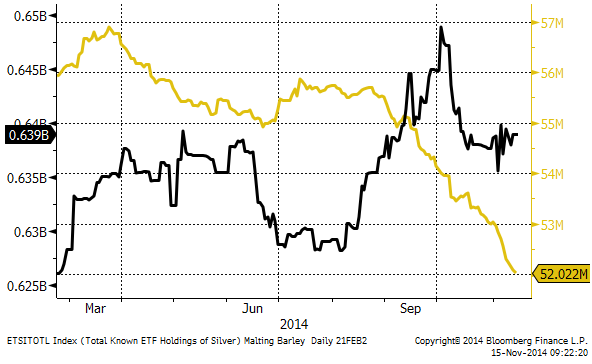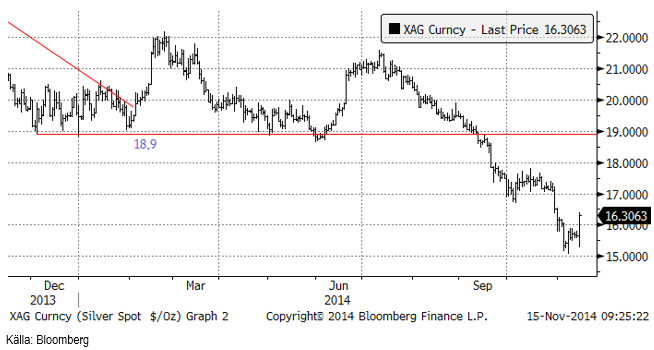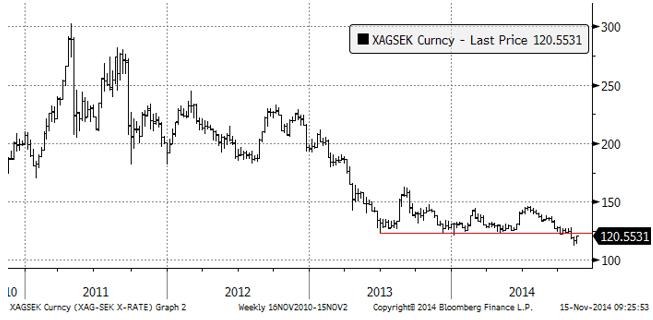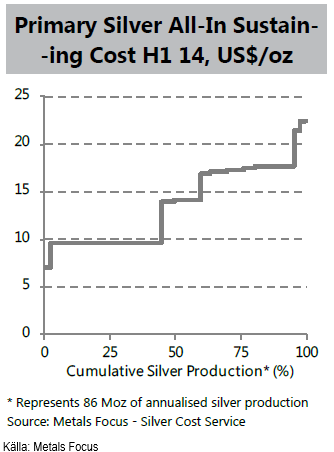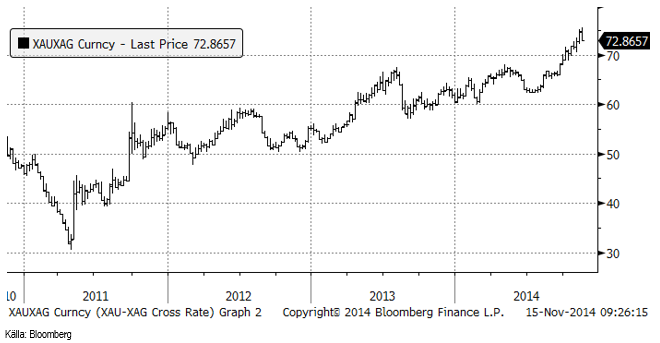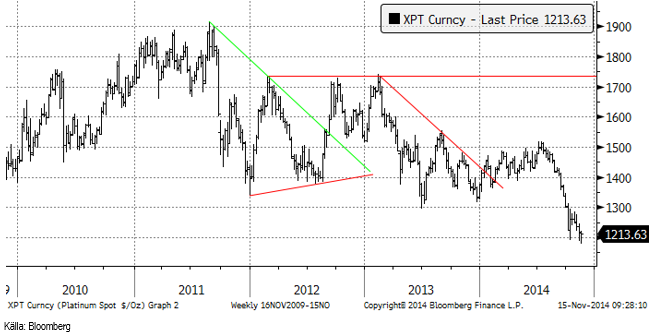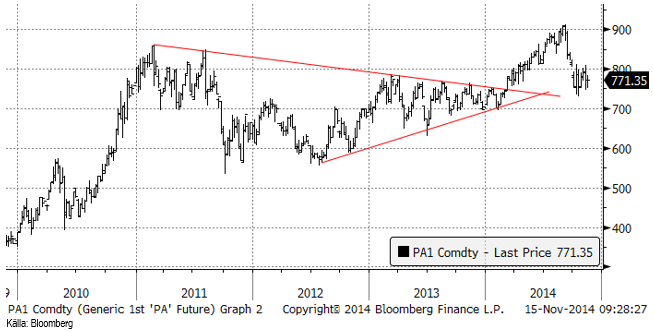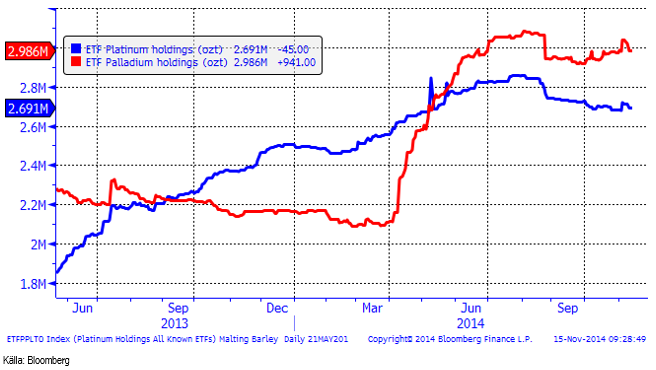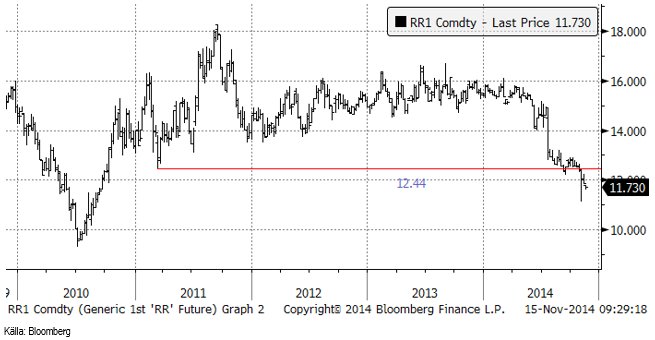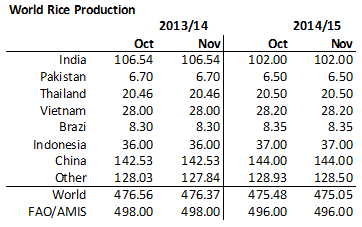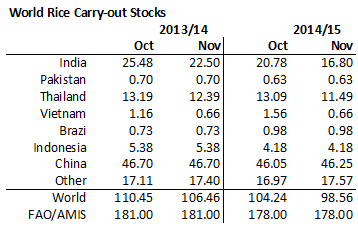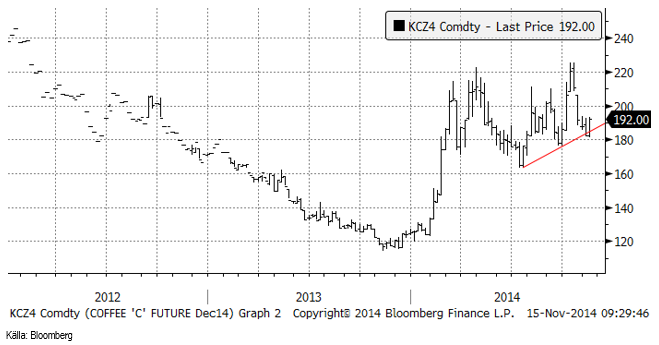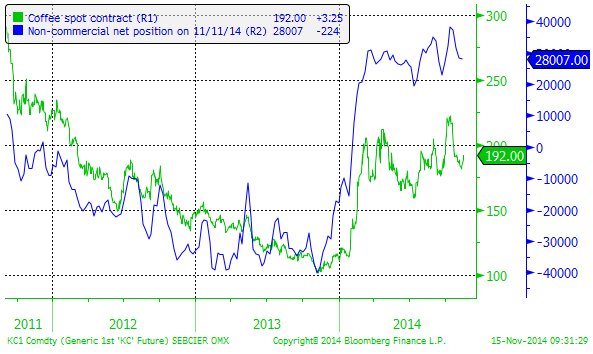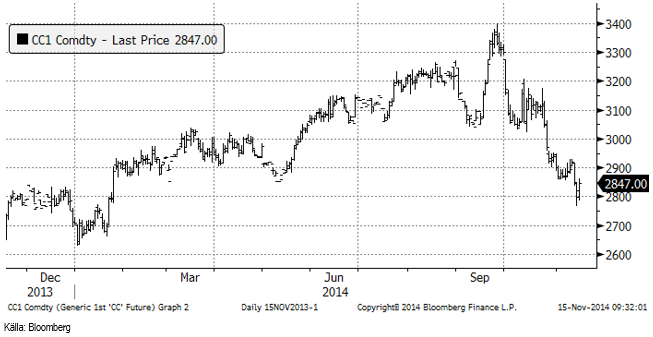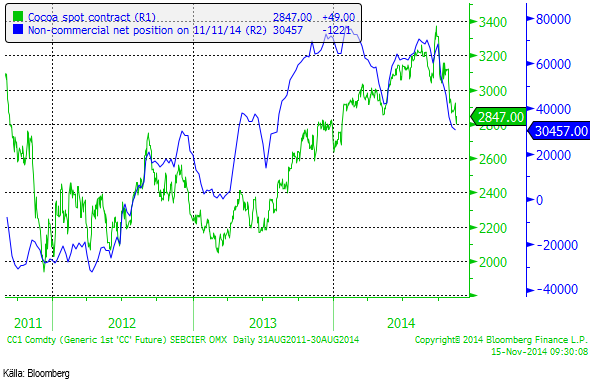Analys
SEB – Råvarukommentarer, 17 november 2014

Veckans rekommendationer
Råolja – Brent
Råoljepriset sjönk återigen och gick för första gången på flera år under 80 dollar per fat. Det skedde en rask återhämtning i fredags.
Lagren i USA minskade med 1.8 miljoner fat från förra veckan. Det är ovanligt att se lagerminskningar vid den här tiden på året. Lagret på 378.4 miljoner fat är 10 miljoner fat lägre än vid samma vecka förra året.
US Energy Information Administration (EIA), rapporterade i sin Short-Term Energy Outlook i onsdags att produktionen av råolja nådde 8.9 mbpd i oktober och väntas överstiga 9 mbpd i december. De sänkte prognosen för helåret 2015 med 0.1 mbpd till en genomsnittlig produktion på 9.4 mbpd. Även det blir den högsta produktionstakten sedan 1972.
International Energy Agency (IEA), som är OPEC:s motsvarighet för de oljekonsumerande länderna, publicerade en rapport i fredags, där de säger att global oljekonsumtion minskar med 1% till 92.6 mbpd under det första kvartalet nästa år. Om det inte blir nya produktionsstörningar kommer detta att pressa priset nedåt, skriver IEA. IEA tror att konsumtionen för helåret 2015 stiger till 93.6 mbpd, från 92.4 i år. Den prognosen är samma som de hade i oktober. Däremot sänktes behovet av olja från OPEC från 29.6 mbpd till 29.2 mbpd. Man skrev vidare att medan ett lägre oljepris kan minska investeringarna i amerikansk skifferolja, så skriver de att detta mer än väl balanseras av ökningen i produktivitet; ”pale in comparison” är uttrycket de använder.
IEA skriver också att globala oljelager ligger över medelvärdet för de senaste fem åren för första gången på ett och ett halvt år. Lagren uppgick till 2.72 miljarder fat i september, och ökade när lagren normalt sett sjunker.
OPEC:s sammanträde i Wien den 27 november rycker allt närmare. Algeriet och Venezuela sade i torsdags att de är redo att försvara oljepriset; förmodligen dock bara om de får sällskap.
Nedan ser vi ett diagram på antalet oljeriggar i USA, enligt Baker Hughes statistik (svart). Antalet riggar i drift ökade med tre från förra veckan till 1928 stycken enligt fredagskvällens statistik.
Vi rekommenderar en kort position, t ex med BEAR OLJA X2 S.
Elektricitet
Priset på första kvartalets terminskontrakt på det nordiska elpriset har fallit ganska kraftigt den här veckan och det beror på väderleksprognosen som pekar på 60-70% av normal nederbörd. I prognosen ser vi också milt väder, 2-3 grader över normal temperatur. Fyra-veckors prognosen från SMHI anger att det blir milt väder i fyra veckor till. Den brukar dock ha lite lägre tillförlitlighet, men det påverkar naturligtvis priserna.
Kärnkraften går på 88% av full kapacitet i de nordiska länderna. Det sista blocket kommer tillbaka om några veckor.
CO2 har däremot handlat starkt. Den senaste överenskommelsen mellan Kina och USA om utsläpp kan också tolkas som positiv för priset på utsläppsrätter i EU. Däremot föll priset ganska kraftigt i fredags, från 6.80 euro per ton till 6.62, vilket gjorde att det blev en nedgång på veckan. Det finns också alternativa tolkningar av Kina/USA-överenskommelsen, som inte är så bullish CO2. Den republikanska majoriteten kommer knappast att godkänna Obamas utfästelser och Kina gjorde inga alls, utan sade att de kommer att öka utsläppen av CO2 åtminstone till år 2030.
Nedan ser vi kvoten mellan priset på terminen för tysk el under första kvartalet och terminen för nordisk el för samma kvartal. Tysk el har inte fallit i pris på samma sätt under hösten som nordisk el har gjort, utan snarare gått upp något lite. Sedan september har skillnaden minskat från noll till 9.45%.
Hydrologisk balans har enligt 2-veckors prognosen fallit tillbaka ytterligare. Förra veckan prognosticerades ett underskott på 4 TWh och nu har underskottet ökat till -7.5 TWh.
Nedan ser vi terminskontraktet för leverans av kol under 2015, som stigit lite den senaste veckan.
Naturgas
Naturgaspriset (decemberkontraktet) tvärvände ner till 4.20 nivån först och efter EIA:s rapport rasade priset vidare ner mot botten på den tidigare ’tradingrangen’ vid 3.88, där den jämna siffran 4 dollar också fungerar som ett tekniskt stöd.
US Energy Information Administration (EIA), rapporterade i sin Short-Term Energy Outlook i onsdags att lagren av naturgas i USA var 6% lägre än samma tid förra året och 7% under genomsnittet för de senaste fem åren (2009 – 2013). Trots detta anser EIA att Henry Hub-priset kommer att handlas till i genomsnitt 3.97 dollar per MMBtu i vinter, vilket är under såväl förra årets genomsnittspris på 4.53 dollar och lägre än priset förra veckan. Orsaken är att produktionen av naturgas är mycket högre nu än förra året.
Koppar
Priset på koppar pendlade med stora svängar inom intervallet 6600 – 6700 dollar förra veckan och stängde nära toppen. Cash till tremånader handlade på 70 dollar i backwardation. Metal Bulletin uppmärksammade att det kan förekomma köp till kinas strategiska reserv (SRB). Lagret i kinesiska lagerhus har enligt de flesta källorna halverats från 1 mt till 0.5 mt efter Qingdao-skandalen. Folk har väntat på att det här materialet skulle dyka upp i LME:s lagerhus, men så har inte skett. En teori är att SRB har tagit hand om materialet. Det skulle kunna vara en rimlig förklaring till varför metallen inte har dykt upp någon annanstans. Tekniskt trendar priset fortfarande nedåt, men det finns tecken på att botten i trenden är nådd. Vi tror att kopparpriset kommer att följa resten av basmetallerna (snarare än att leda uppgången) mot slutet av året.
Koppar är den enda metallen som handlas på en amerikansk terminsbörs och är därför den enda vi får någon information om vad spekulanterna gör. Som vi ser nedan är de fortfarande rätt sålda (-25561 kontrakt) koppar, men köpte 302 kontrakt netto i veckan som gick.
Vi håller fast vid vår rekommendation av KOPPAR S.
Aluminium
Aluminium skiljer ut sig från de andra i basmetallgruppen. Den senaste tiden har aluminiumpriset utvecklats mest positivt, men i veckan som gick var det den enda metallen som gick ner i pris. Investerarna tar från tid till annan kommandot i marknaden. Marknadskommentarerna i veckan löd ”CTAs köper” och nästa dag ”CTAs tar hem vinster”. Det behöver inte vara sant, förstås. Det är få personer, för att inte säga, ingen, som vet vem som gör alla köp och försäljningar och det kan vara lockande att säga att det var några rika och hemlighetsfulla fonder som orsakade prisrörelserna. Vi tror att aluminium har några månader med stark efterfrågan framför sig. Det stämmer överens med den tekniska bilden också. De längre kontrakten fortsätter att vara under prispress. Skillnaden mellan tremånaders terminspris och femtonmånaders är nu bara 15 dollar i contango, ner från 30-50 dollar tidigare i november. Det kan tyda på att producenter har börjat prissäkra sin produktion.
Vi fortsätter att rekommendera köp av ALUMINIUM S.
Zink
Kursdiagrammet för zink ser ut på ungefär samma sätt som koppar. Det verkar som om marknaden vill testa den övre gränsen för den fallande pristrenden. Det fundamentala underskottet i marknaden har ännu inte blivit kännbart och investerare som har köpt in sig i metallen, har gått i och ur marknaden och därmed skapat en volatil marknad i svag trend nedåt. Ett orosmoment som diskuteras i marknaden är att 93% av LME-lagret finns i USA. Med så begränsad del i EU och i Asien, kan det lätt bli en brist när underskottet letar sig ner genom systemet. Vi tror att marknaden kommer att stärkas till slutet på året. Däremot tror vi att en större prisuppgång kan ske först någon gång under nästa år.
Vi rekommenderar köp av ZINK S.
Nickel
LME-lagret steg inte i veckan och prisraset ser ut att bottna ut. Industrins orderingång och PMI-statistiken indikerar att industriproduktionen kan vara på väg att växa och i det läget kan man förvänta sig lageruppbyggnad hos företagen. Kommentarer från tillverkarna av rostfritt stål i veckan, antyder just att kunder fyller på sina lager och drar nytta av det låga nickelpriset. Det här brukar normalt rassla ner genom systemet och bli köp på terminsmarknaden på LME. Håller något avgörande på att ske i marknaden? Det är svårt att svara på, naturligtvis, men i linje med vår uppfattning, skulle det kunna vara dags för priset att byta riktning.
Vi rekommenderar köp av NICKEL S.
Guld
Guldpriset steg mycket kraftigt i fredags, men är tekniskt begränsat på uppsidan.
Chartet för guld i kronor steg likaså.
Metals Focus publicerade en kostnadskurva (totala kostnader) för ett större urval guldproducenter. I kurvan, som vi ser nedan, ser vi att vid ett pris på 1200 dollar är det nästan all gruvkapacitet som visar vinst.
World Gold Councils rapport ’Gold Demand Trends Third Quarter 2014’ som publicerades i torsdags visade 23.5 ton lägre efterfrågan totalt sett jämfört med det tredje kvartalet förra året. Den största förändringen är en minskning av smyckesefterfrågan på 22 ton till 534.2 ton för det tredje kvartalet i år.
Centralbanker köpte nästan 9 ton mindre guld det tredje kvartalet i år jämfört med förra året, från 101.5 ton till 92.8 ton i år. Störst köp har Russland gjort, 55 ton, därefter Kazakstan, 28 ton och Azerbaijan, 7 ton, alla medlemmar av CIS. Reuters rapporterade att Rysslands köp beror på att de ryska bankerna som normalt sett förmedlar de ryska gruvbolagens export av metallen, har svårt att göra detta efter ovilja i väst att göra affärer med Ryssland och att det istället säljs till den ryska centralbanken.
Investeringsefterfrågan ökade med 12.4 ton, men inom den kategorin skedde stora förändringar. Efterfrågan på tackor och mynt minskade med 66.7 ton till 245.6 ton. Utflödet från börshandlade värdepapper som representerar guld minskade dock med 78.9 ton från ett utflöde på 120.2 ton under det tredje kvartalet förra året till ett utflöde på 41.3 ton samma kvartal i år.
WGC sade också i rapporten att efterfrågan på guld i alla former sjönk för det tredje kvartalet i rad till 182.7 ton. Det är 37% mindre än samma kvartal förra året.
Som vi skrev förra veckan, verkat det som om efterfrågan på fysisk metall i investeringssyfte i USA och EU har tagit mer fart under början av det fjärde kvartalet, efter att guld blivit ännu lite billigare.
Institutionella investerare har sålt 0.54 miljoner uns i ETF/ETC-er sedan förra veckan. Det är 17.4 ton, vilket är en siffra som man kan jämföra med t ex centralbankernas köp ovan. Flödet i ETF/ETC betyder alltså väldigt mycket.
Vi håller fast vid positionen i GULD S.
Silver
Silverpriset hängde på guldet upp i fredags, men det finns ännu inte någon trendförändring. Trenden är fortfarande nedåtriktad.
Silverpriset i kronor, nedan visat i ett veckochart, ser fortfarande väldigt negativt ut. Visst kan en rekyl upp mot 125 kronor per uns (31 gram) komma, men en sådan skulle enligt handboken i teknisk analys bara vara ett säljtillfälle.
Metals Focus publicerade även en kostnadskurva för producenter av silver. Notera att vid ett pris på 16 dollar går en stor del av producenterna med förlust.
Silver är fortsatt billigt i förhållande till guld och det kan vara en anledning att byta en investering i guld mot silver. Kvoten föll tillbaka förra veckan till samma nivå som den låg på för två veckor sedan.
Vi går över till neutral rekommendation. Det är en svår bedömning. Tekniskt borde silver vara säljvärt nu, men fundamentalt sett är silver köptvärt – dels för att det är billigt i förhållande till guld och dels för att en så stor andel av producenterna går med förlust.
Platina & Palladium
Platina noterade det lägsta priset på fem år i veckan som gick, innan priset hämtade sig.
Palladiumpriset är i princip oförändrat från förra veckan och befinner sig fortfarande i konsolidering. Det går dock inte att utesluta ett prisfall ända ner till 600 dollar, även om vårt huvudscenario är att priset vänder uppåt när konsolideringen i prisintervallet 750 till 800 dollar är klar.
Nedanför ser vi hur mycket metall som finns i börshandlade fonder för platina respektive palladium. Investerare har sålt både platina och palladium den senaste veckan.
Vi fortsätter med neutral rekommendation på platina, men rekommenderar köp av palladium via t ex PALLADIUM S.
Ris
Priset på ris fortsatte att gå ner och stängde på 11.73 dollar per cwt.
WASDE-rapporten var helt neutral. USDA gör ingen förändring alls för de stora producentländerna i världen, men en liten sänkning bland övriga producenter, vilket leder till en marginell minskning av estimatet för global produktion från oktobers rapport till novembers.
USDA sänker estimatet för utgående lager 2013/14 med 4 mt, (3 mt lägre i Indien och 1 mt lägre i Thailand), vilket leder till 4 mt lägre utgående lager 2014/15. Att vi ser en sänkning av globala utgående lager 2015 från 104.24 mt enligt förra månadens rapport till 98.56 mt i novemberrapporten beror alltså inte på någon justering av produktionen eller konsumtionen för innevarande år.
Kaffe
Kaffepriset vände upp från det tekniska stödet vid 180 cent och stängde på 192 cent per pund i decemberkontraktet. Trots att det regnar en hel del i Brasilien, kom några nyhetsrapporter mot slutet av veckan, som huvudsakligen var intervjuer med mäklare i São Paulo, som menade att regnen inte var tillräckliga. Detta räckte uppenbarligen för att få upp priset lite grand. Frågan är hur mycket dessa uttalanden faktiskt korresponderar mot den verkliga situationen.
Som vi sett ovan under odlingsväder är chanserna goda för ett El Niño från Jul och det skulle innebära en period av hög nederbörd. På lite längre sikt är alltså utsikterna rätt ”bearish”.
Det kom också rapporter om robustan i Vietnam har små bönor i år. Det kan också ha bidragit till prisuppgången i veckan.
Som vi ser i nedanstående diagram är non-commercials fortfarande nettoköpta över 28,000 kontrakt. Det var nästan ingen förändring alls den senaste veckan.
Kakao
Kakaopriset gick ner från 2900 till 2800 dollar, men rekylerade sedan i fredags och stängde på 2847. Fredagens uppgång behöver inte betyda att nedgången vänder utan det kan handla om vinsthemtagningar inför helgen.
I torsdags släppte Liberia på reserestriktionerna inom landet och det kan ha påverkat marknaden under onsdagen och torsdagen.
Non-commercials fortsätter sälja av terminer på kakao, förra veckan dock bara 1221 kontrakt.
Vi behåller positionen i SHORT KAKAO A S
För fler analyser på jordbruksråvaror se SEBs andra analysbrev.
[box]SEB Veckobrev Veckans råvarukommentar är producerat av SEB Merchant Banking och publiceras i samarbete och med tillstånd på Råvarumarknaden.se[/box]
Disclaimer
The information in this document has been compiled by SEB Merchant Banking, a division within Skandinaviska Enskilda Banken AB (publ) (“SEB”).
Opinions contained in this report represent the bank’s present opinion only and are subject to change without notice. All information contained in this report has been compiled in good faith from sources believed to be reliable. However, no representation or warranty, expressed or implied, is made with respect to the completeness or accuracy of its contents and the information is not to be relied upon as authoritative. Anyone considering taking actions based upon the content of this document is urged to base his or her investment decisions upon such investigations as he or she deems necessary. This document is being provided as information only, and no specific actions are being solicited as a result of it; to the extent permitted by law, no liability whatsoever is accepted for any direct or consequential loss arising from use of this document or its contents.
About SEB
SEB is a public company incorporated in Stockholm, Sweden, with limited liability. It is a participant at major Nordic and other European Regulated Markets and Multilateral Trading Facilities (as well as some non-European equivalent markets) for trading in financial instruments, such as markets operated by NASDAQ OMX, NYSE Euronext, London Stock Exchange, Deutsche Börse, Swiss Exchanges, Turquoise and Chi-X. SEB is authorized and regulated by Finansinspektionen in Sweden; it is authorized and subject to limited regulation by the Financial Services Authority for the conduct of designated investment business in the UK, and is subject to the provisions of relevant regulators in all other jurisdictions where SEB conducts operations. SEB Merchant Banking. All rights reserved.
Analys
Tightening fundamentals – bullish inventories from DOE

The latest weekly report from the US DOE showed a substantial drawdown across key petroleum categories, adding more upside potential to the fundamental picture.

Commercial crude inventories (excl. SPR) fell by 5.8 million barrels, bringing total inventories down to 415.1 million barrels. Now sitting 11% below the five-year seasonal norm and placed in the lowest 2015-2022 range (see picture below).
Product inventories also tightened further last week. Gasoline inventories declined by 2.1 million barrels, with reductions seen in both finished gasoline and blending components. Current gasoline levels are about 3% below the five-year average for this time of year.
Among products, the most notable move came in diesel, where inventories dropped by almost 4.1 million barrels, deepening the deficit to around 20% below seasonal norms – continuing to underscore the persistent supply tightness in diesel markets.
The only area of inventory growth was in propane/propylene, which posted a significant 5.1-million-barrel build and now stands 9% above the five-year average.
Total commercial petroleum inventories (crude plus refined products) declined by 4.2 million barrels on the week, reinforcing the overall tightening of US crude and products.


Analys
Bombs to ”ceasefire” in hours – Brent below $70

A classic case of “buy the rumor, sell the news” played out in oil markets, as Brent crude has dropped sharply – down nearly USD 10 per barrel since yesterday evening – following Iran’s retaliatory strike on a U.S. air base in Qatar. The immediate reaction was: “That was it?” The strike followed a carefully calibrated, non-escalatory playbook, avoiding direct threats to energy infrastructure or disruption of shipping through the Strait of Hormuz – thus calming worst-case fears.

After Monday morning’s sharp spike to USD 81.4 per barrel, triggered by the U.S. bombing of Iranian nuclear facilities, oil prices drifted sideways in anticipation of a potential Iranian response. That response came with advance warning and caused limited physical damage. Early this morning, both the U.S. President and Iranian state media announced a ceasefire, effectively placing a lid on the immediate conflict risk – at least for now.
As a result, Brent crude has now fallen by a total of USD 12 from Monday’s peak, currently trading around USD 69 per barrel.
Looking beyond geopolitics, the market will now shift its focus to the upcoming OPEC+ meeting in early July. Saudi Arabia’s decision to increase output earlier this year – despite falling prices – has drawn renewed attention considering recent developments. Some suggest this was a response to U.S. pressure to offset potential Iranian supply losses.
However, consensus is that the move was driven more by internal OPEC+ dynamics. After years of curbing production to support prices, Riyadh had grown frustrated with quota-busting by several members (notably Kazakhstan). With Saudi Arabia cutting up to 2 million barrels per day – roughly 2% of global supply – returns were diminishing, and the risk of losing market share was rising. The production increase is widely seen as an effort to reassert leadership and restore discipline within the group.
That said, the FT recently stated that, the Saudis remain wary of past missteps. In 2018, Riyadh ramped up output at Trump’s request ahead of Iran sanctions, only to see prices collapse when the U.S. granted broad waivers – triggering oversupply. Officials have reportedly made it clear they don’t intend to repeat that mistake.
The recent visit by President Trump to Saudi Arabia, which included agreements on AI, defense, and nuclear cooperation, suggests a broader strategic alignment. This has fueled speculation about a quiet “pump-for-politics” deal behind recent production moves.
Looking ahead, oil prices have now retraced the entire rally sparked by the June 13 Israel–Iran escalation. This retreat provides more political and policy space for both the U.S. and Saudi Arabia. Specifically, it makes it easier for Riyadh to scale back its three recent production hikes of 411,000 barrels each, potentially returning to more moderate increases of 137,000 barrels for August and September.
In short: with no major loss of Iranian supply to the market, OPEC+ – led by Saudi Arabia – no longer needs to compensate for a disruption that hasn’t materialized, especially not to please the U.S. at the cost of its own market strategy. As the Saudis themselves have signaled, they are unlikely to repeat previous mistakes.
Conclusion: With Brent now in the high USD 60s, buying oil looks fundamentally justified. The geopolitical premium has deflated, but tensions between Israel and Iran remain unresolved – and the risk of missteps and renewed escalation still lingers. In fact, even this morning, reports have emerged of renewed missile fire despite the declared “truce.” The path forward may be calmer – but it is far from stable.
Analys
A muted price reaction. Market looks relaxed, but it is still on edge waiting for what Iran will do

Brent crossed the 80-line this morning but quickly fell back assigning limited probability for Iran choosing to close the Strait of Hormuz. Brent traded in a range of USD 70.56 – 79.04/b last week as the market fluctuated between ”Iran wants a deal” and ”US is about to attack Iran”. At the end of the week though, Donald Trump managed to convince markets (and probably also Iran) that he would make a decision within two weeks. I.e. no imminent attack. Previously when when he has talked about ”making a decision within two weeks” he has often ended up doing nothing in the end. The oil market relaxed as a result and the week ended at USD 77.01/b which is just USD 6/b above the year to date average of USD 71/b.

Brent jumped to USD 81.4/b this morning, the highest since mid-January, but then quickly fell back to a current price of USD 78.2/b which is only up 1.5% versus the close on Friday. As such the market is pricing a fairly low probability that Iran will actually close the Strait of Hormuz. Probably because it will hurt Iranian oil exports as well as the global oil market.
It was however all smoke and mirrors. Deception. The US attacked Iran on Saturday. The attack involved 125 warplanes, submarines and surface warships and 14 bunker buster bombs were dropped on Iranian nuclear sites including Fordow, Natanz and Isfahan. In response the Iranian Parliament voted in support of closing the Strait of Hormuz where some 17 mb of crude and products is transported to the global market every day plus significant volumes of LNG. This is however merely an advise to the Supreme leader Ayatollah Ali Khamenei and the Supreme National Security Council which sits with the final and actual decision.
No supply of oil is lost yet. It is about the risk of Iran closing the Strait of Hormuz or not. So far not a single drop of oil supply has been lost to the global market. The price at the moment is all about the assessed risk of loss of supply. Will Iran choose to choke of the Strait of Hormuz or not? That is the big question. It would be painful for US consumers, for Donald Trump’s voter base, for the global economy but also for Iran and its population which relies on oil exports and income from selling oil out of that Strait as well. As such it is not a no-brainer choice for Iran to close the Strait for oil exports. And looking at the il price this morning it is clear that the oil market doesn’t assign a very high probability of it happening. It is however probably well within the capability of Iran to close the Strait off with rockets, mines, air-drones and possibly sea-drones. Just look at how Ukraine has been able to control and damage the Russian Black Sea fleet.
What to do about the highly enriched uranium which has gone missing? While the US and Israel can celebrate their destruction of Iranian nuclear facilities they are also scratching their heads over what to do with the lost Iranian nuclear material. Iran had 408 kg of highly enriched uranium (IAEA). Almost weapons grade. Enough for some 10 nuclear warheads. It seems to have been transported out of Fordow before the attack this weekend.
The market is still on edge. USD 80-something/b seems sensible while we wait. The oil market reaction to this weekend’s events is very muted so far. The market is still on edge awaiting what Iran will do. Because Iran will do something. But what and when? An oil price of 80-something seems like a sensible level until something do happen.
-

 Nyheter3 veckor sedan
Nyheter3 veckor sedanStor uppsida i Lappland Guldprospekterings aktie enligt analys
-

 Nyheter4 veckor sedan
Nyheter4 veckor sedanBrookfield ska bygga ett AI-datacenter på hela 750 MW i Strängnäs
-

 Nyheter4 veckor sedan
Nyheter4 veckor sedanSommaren inleds med sol och varierande elpriser
-

 Nyheter3 veckor sedan
Nyheter3 veckor sedanSilverpriset släpar efter guldets utveckling, har mer uppsida
-

 Analys4 veckor sedan
Analys4 veckor sedanBrent needs to fall to USD 58/b to make cheating unprofitable for Kazakhstan
-

 Nyheter4 veckor sedan
Nyheter4 veckor sedanTradingfirman XTX Markets bygger datacenter i finska Kajana för 1 miljard euro
-

 Nyheter2 veckor sedan
Nyheter2 veckor sedanUppgången i oljepriset planade ut under helgen
-

 Nyheter2 veckor sedan
Nyheter2 veckor sedanLåga elpriser i sommar – men mellersta Sverige får en ökning


